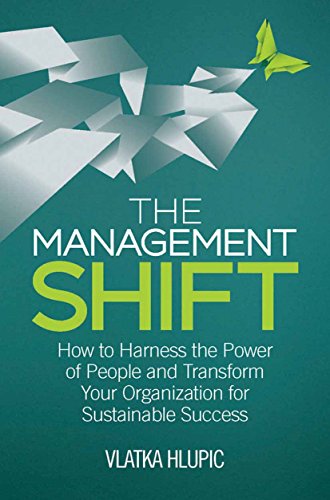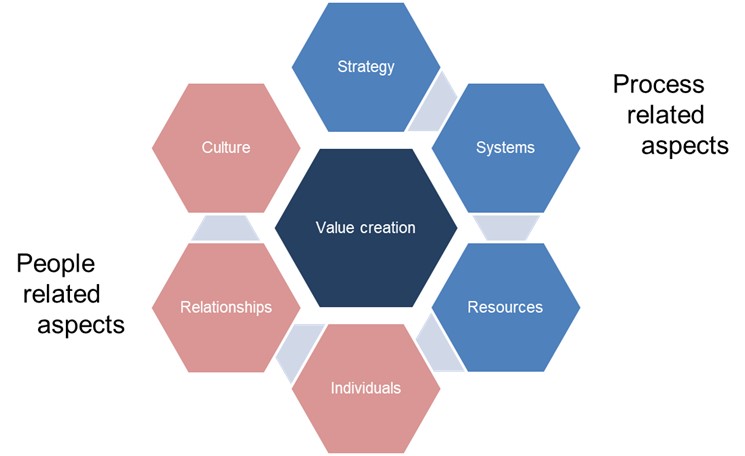
I completed my MBA two decades ago although I consume the latest management books voraciously. This 2014 book by Professor Vlatka Hluplic didn’t appear on my radar but I had the privilege of meeting the author through my work with the Managing Partners Forum. And I’m so glad that I did as it’s an important contribution to modern management thinking and a must-read for anyone leading a people business. It also highlights two key models – for which there are assessments – on which to base leadership and organizational transformation. So here’s a book review: The Management Shift – How to harness the power of people and transform your organization for sustainable success by Vlatka Hlupic.
In a nutshell
The core message of the book is the need to move away from a “command and control” model of management towards a more collaborative and inclusive style of people leadership. Emergent leadership is needed for our rapidly changing, unpredictable, global business environment. The book describes why we need to change, what needs to change and how to change. It focuses on people, purpose, collaboration and innovation.
There are two models – one on the five levels of individual and organisational development (which is reminiscent of the management levels in Jim Collins’ “Good to great”) and the 6 box model of leadership (which is similar to McKinsey’s 7S model). These are shown below.
The great strengths of the book – the astonishing grasp of a wealth of management thinking, academic research (over 20 years of interdisciplinary research) and rigorous and original empirical research – is also a bit of a weakness. It’s an intense read (188 pages and then a further 50 pages of appendices) so you may be tempted to abandon the book during the “why” and “what” before you get to the important, practical stuff on “how” to change. My usual method of reading such a book is to underline the key points. But with this book almost every page is littered with numerous underlines and stars! I urge you to persevere with it.
The author
Vlatka Hlupic is Professor of Business and Management at the University of Westminster, a former Adjunct Faculty at London Business School and Chief Executive Officer of the Drucker Society, London.
She has published more than 160 academic articles, including the award-winning Harvard Business Review article “To be a better leader, give up authority” and had numerous appearances in the business media. She is considered one of the most influential HR speakers.
At the start of this 30 minute video Vlatka explains the five levels for individuals and organisations and the 6 box leadership model
Management Shift Solutions Limited
Book Contents
There is a helpful introduction, summary and extensive references to each chapter.
1. Why it is time now for the management shift
“Organizations today are surfing on the edge of chaos”
“There is ample research evidence that in dynamic and complex business environments this traditional approach inhibits creativity and innovation and decreases motivation and productivity”.
This chapter contains an astonishing number of statistics that demonstrate the numerous problems caused by the old style of management (which the author refers to as Management 1.0 after Frederic Taylor’s “The principles of Scientific Management”).
It highlights the problem of too much focus on short-term share price at the expense of long-term sustainable performance. It describes how the new connected era is changing how people engage.
The proposed solution is Management 2.0 principles (collaboration, transparency, meritocracy, purpose, community and autonomy) where authority is distributed and decisions are made on the basis of knowledge rather than formal position in organizational hierarchy.
The author points to many great leadership thinkers – Peter Drucker, Henry Mintzberg, Gary Hamel and Charles Handy – who recognised the need for the shift. She uses the metaphor of moving from a mechanistic to living systems management style.
There’s a helpful table comparing traditional and emerging management concepts and approaches. Then – as if you needed any further persuasion – there are examples of companies implementing emerging management practices and doing well financially with mentions of David Wolfe and Jac Sheth’s “Firms of Endearment” and John Kotter and James Heskett’s “Corporate Culture and Performance”.
2. The need for a new type of leadership
“In this approach, leaders strive to serve, to inspire others to find purpose and calling in the work they do, to unleash their passion and creativity and to use all internal resources and intrinsic motivation to provide exceptional service”. There’s reference to Stephen Covey’s comment “Leaders should find their unique human voice by helping others to find theirs”.
The need for purpose, community, respect for people and decentralisation features prominently in the ideas of Peter Drucker. There are inspirational examples from leaders at Yahoo!, Saatchi & Saatchi, Timberland as well as a US management consultancy.
The new leadership approach is about interacting through informal networks, experimentation, learning, facilitating, coaching and enabling. “In knowledge organizations, emergent leadership is not about delegating tasks and monitoring results; it is about imbuing the entire workforce with a sense of responsibility for the business”.
There is another incredibly helpful table comparing traditional and emergent leadership behaviours. Based on the understanding that “organizations behave like complex adaptive systems (CAS) comprising autonomous individuals or groups who act in unpredictable ways”.
There is yet more research diligently listed to support these arguments. And the section on “Leading knowledge workers is different” (e.g “treat them as partners and associates rather than subordinates”, “give workers a sense of purpose mastery and autonomy”, “so they need flexible working arrangements”) will resonate strongly with professional service firms. And also the concept that we are transitioning from the knowledge economy to the creative economy where the driving force is innovation.
Steve Denning (founder of the Stoos movement) argues we live in an aggregate of three very different economies – the Traditional Economy, Financial Capitalism and the Creative Economy.
There is a synthesis of a review of over 400 article and books on leading knowledge workers which develops a model showing the individual and group process contexts in leadership for innovation.
There’s a summary of a project looking at how to implement emergent leadership in two knowledge-based organizations and seven key areas are described in the rest of the chapter:
- Facilitating informal networks (ask questions such as “Who knows what?” and incorporate network development in organizational routines, processes and training)
- Organic growth based on expertise (allow groups and communities of interest to form and the self-selection of leaders)
- Develop a caring organizational culture based on intrinsic motivation
- Collaborate and cross-fertilize ideas between teams
- Develop trust, allow experimentation and tolerate mistakes
- Distribute responsibility, decision-making and control (and voluntary leadership)
- Senior management support
The chapter ends with case studies of companies that have implemented emergent leadership – Semco, HCL Technologies, Brand Velocity Inc, Whole Foods Market, W.L Gore & Associates, CSC Germany and Zappos.com.
3. Insights from the Leading Management Thinkers: from the Why and What to the How
This chapter provides a summary of the key ideas on management innovation from the leading management thinkers. Mentions include: Simon Sinek (“Start with why” on purpose), The Thinkers50 list and Steve Denning. The author then helpfully organises the key ideas into groups.
The perception is that strategy is changing and she reviews the outdated competitive strategy models of Michael Porter through to Rita Gunter McGrath’s view on the end of competitive advantage. She summarises the key emerging ideas in the context of strategy as transient competition, long term orientation, focus on customers, need for a higher purpose and building alliances amongst stakeholders.
She quotes Porter “Innovation is the central issue in economic prosperity” and dips into HBS Professor Clayton Christensen’s work – particularly disruptive innovations and his five skills of the innovator’s DNA:
- Associate thinking to make connections
- Ask questions
- Observe what people do (and how and why)
- Network with diverse people (the importance of this is highlighted in Range – How generalists triumph in a specialized world” by David Epstein (kimtasso.com) where a theme is about accumulating knowledge from different domains) and
- Experiment with ideas (where she refers to Seth Godin’s book “Poke the Box”).
A further trend is co-creating, collaborative or open innovation and she explores the ideas of several others here including the idea of crowd storming (where the online space is used for mass brainstorming, problem-solving and innovation). She returns to the impact of leadership style, saying “innovation is a culture rather than an event” (referencing Gary Shapiro’s “Ninja Innovation”). She even reviews Eastern philosophies – the bottom-up approach to innovation – including Buddhist philosophy for fostering innovation articulated by Juliet Melton of IDEO.
She then turns her attention to employee engagement – “Only 13 per cent of employees worldwide are engaged in their jobs”. And suggests that a good way to engage employees is to get them involved in strategic planning (see my thoughts from Take them on the strategy journey (kimtasso.com)). This helps them find meaning and purpose in the work they are doing.
She mentions Jeremy Kourdi and Jacqueline Davies’ claim that successful HR strategies for engaging people include: developing talent, providing flexibility, offering consistent guidance and pursuing meaningful goals. And notes that leadership style is important for engaging employees and reiterated Dan Pontefract’s view that command and control is obsolete: meaningful conversations and storytelling is advocated to enchant employees.
There’s further advice from a HBR article by Rob Goffee and Gareth Jones on what employees require to be most productive which relates to “The Progress Principle”’ – the sentiment that “of all the positive events that influence inner work life, the single most powerful is progress in meaningful work”. And there’s further support from Chip Conley’s book “Peak” and Earle McLeod’s book on “Selling with Noble Purpose”.
4. The Emergent Leadership Model: From the stagnating to the unbound culture
This chapter introduces the model – based on the author’s research – of the five levels that individuals go through during their development and the corresponding organizational culture.
The interdependent relationship between individual and organizational culture is described as a holon (meaning both a whole and a part – coined by Arthur Koestler in “The Ghost in the Machine”).
The metaphor for an organization is seen as a living or complex adaptive system rather than the mechanistic sum of its parts. And there’s further support for this from a HBR article on social intelligence and the biology of leadership by Daniel Goleman (of Emotional Intelligence fame) and Richard Boyatzis (see also Helping people change: Coaching with compassion (kimtasso.com)).
Key characteristics of levels in the Emergent Leadership Model
The author says that a fundamental shift in performance, innovation and engagement occurs when a critical mass of individuals move from Level 3 to Level 4. The dominant mindset becomes “enthusiastic” and culture becomes “collaborative”. Coaching and mentoring can accelerate advancement up the levels.
An Appendix shows how this model maps onto others such as Leadership Development Framework, Barrett’s Value Model, Spiral Dynamics Model and Tribal Leadership.
She then goes on to explore the individual (including leaders) and organisational levels in more detail – showing the associated thoughts, emotions and behaviours. It’s interesting that interpersonal interactions are noted as important at level 4 – where people form informal networks and there is a strong sense of community.
As I read about the lower levels of organisational development I was struck with how some captured the essence of many professional services firms. I was also struck at the statistics indicating that only about 22% organisations operate at the collaborative level.
Triggers for shifting to level 4 culture include: change in business focus and/or change in corporate values, poor financial and market performance, unpredictability of the operating environment, the lack of a formal leader, inadequate engagement, untapped potential of the team, slow or problematic decision-making, poor communication and economic crisis. On this basis, every organization should be changing!
It’s here that the author explains that from her coaching and consulting work she developed assessment tools to help employees move up levels and then developed the 6 Box leadership model.
The 6 Box Leadership Model
5. The 6 Box Leadership Model: An organizational body scan
“A recent synthesis of a large body of the literature on leading knowledge workers reveals that in order to foster innovation in knowledge-based organizations, a different leadership style is needed, based on horizontal rather than vertical leadership, where power and authority are distributed on the basis of knowledge”.
It’s here that the author shows her enthusiasm for Peter Drucker’s work – especially “Management: Tasks, Responsibilities, Practices” which turns ideas into action. And the need to move away from silo thinking and mindset to think holistically, have an open and inquisitive mind, integrate different disciplines and focus on whole brain thinking.
She describes how she drew on extensive materials on leadership and change management approaches and models and conducted additional research into evidence-based organizational change models.
Her theoretical research looked at 1,000 research articles and the empirical research considered 23 case studies – involving more than 300 semi-structured interviews (and details are shown in the appendices).
After developing the framework with factors that drive value creation in organizations, she developed an online questionnaire and conducted a pilot test over two years. There’s a detailed explanation of the study.
And to verify her results she mapped her data onto The Reinvention Framework (Jack Bergstrand), Management 2.0 principles (Gary Hamel) and the key ideas of Peter Drucker. It’s a bit of a methodological overload – but the author can’t be faulted on her academic rigour. She then describes how she used the four mappings to cross-check her survey results. She shares her consulting process for implementing 6 Box Leadership:
- Initial meeting with executive group
- Link to the questionnaire is sent to participants
- The raw data is analyzed so a company-specific report is sent showing strengths and development opportunities and an action plan
- The report and action plan is presented to the Executive Group
- Once implemented, the impact is monitored every three to six months
(She mentions that the model can be used to achieve Jim Collins’ Flywheel Effect (see Classic management book reviews – The McKinsey way, Good to great (kimtasso.com))
6. The 6 Box Leadership Model in Action: Practical Examples
The case studies include:
- US management consultancy – facilitating strategy for growth
- The City of London Insurance Company – Engaging employees
- UK National Health Service Trust – Improving employee engagement and customer service
- Nordic IT consultancy – A life-changing experience
7. The Management Shift is Achievable NOW: A call to action
This is a final plea for a transformation that requires radically different thinking and management practices. It mentions the author’s work with the humanistic aspects of management embodied within and promoted by the Drucker Trust to develop future leaders.
The author advocates the connection of many areas to achieve the required management paradigm shift: governance, management, education, labour, finance, legal, media and sustainability. She mentions groups such as Management Innovation eXchange, The Stoos Network and The People Cloud Thought Leadership. She offers a provocative thought that in order to fly you must give up being a caterpillar.
She ends with a powerful and persuasive comment: “In the same way that decentralised market economies outperform centrally planned and control economies, companies with decentralised organizational cultures, operating at Levels 4 and 5, outperform highly centralised hierarchical organizations operating at Levels 1-3”.
My conclusion
The book is a tough but rewarding read for anyone interested in strategy, leadership, transformation, change management and organizational development: leaders, senior managers, human resource professionals and management consultants.
The author taps into an extensive body of management thinking that has shaped modern business leadership and strategy. It elegantly and persuasively demonstrates the link between individual and organizational behavioural and cultural change.
While the amount of information in the book is overwhelming at times, there are frequent helpful summaries. I particularly liked the table of key models shown in Appendix 3 providing an “at a glance” overview of the Balanced Scorecard, McKinsey’s 7 S framework, Christensen’s RVP (Resources Value Processes) Framework, Tribal Leadership, Jim Collins’ Good to Great and Barratt’s Seven Levels of Organizational Consciousness.
The author writes in such a pleasantly down-to-earth and simple style that it’ almost a joy to read.
Other points of interest:
- A summary of the research in the book was submitted as written evidence to the All-Party Parliamentary Group on Management and was included in the report “Management 2020” produced by the Commission on the Future of Management and Leadership and Chartered Management Institute (CMI). Management 2020 – Leadership to unlock long-term growth (managers.org.uk)
- The cost of poor management in the UK is over £19.3 billion per year in lost working hours, productivity output in the UK is 21% lower than the G7 average, 43 % of UK line managers rate their managers as ineffective and only 34% of employers provide management training.
- The Management 2.0 Hackathon (an online community of over 20,000 leading management thinkers and practitioners) generated a set of principles that organisations should adopt (openness, community, meritocracy, activism, collaboration, meaning, autonomy, serendipity, decentralisation, experimentation, speed and trust).
Note: Collaboration – a key theme in The Management Shift – is also one of the four key themes in the fantastic book by Greg Orme The Human Edge – How curiosity and creativity are your superpowers (kimtasso.com)











